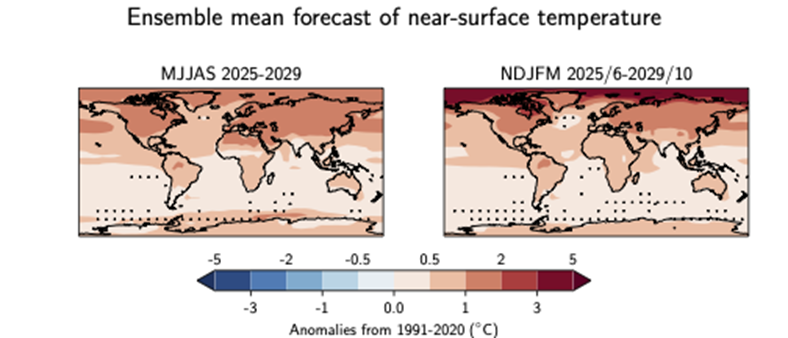Global climate predictions show temperatures expected to remain at or near record levels in coming five years
Author: Grahame Madge
05:00 (UTC+1) on Wed 28 May 2025
The latest prediction of global climate [issued today, Wednesday 28 May 2025] suggests the average global temperature is likely to continue to reach record or near-record levels in the coming five years.
This level of warming will increase climate risks, especially for vulnerable societies. Although the average temperature over the next five years is likely to exceed 1.5°C above pre-industrial levels this does not represent a breach of the Paris Agreement, which refers to a long-term warming typically over 20 years.
The world’s global average temperature exceeded 1.5°C above the 1850-1900 average last year (2024) for the first time in the observational record. This was in part due to the El Niño phase of a natural cycle of climate variation in the tropical Pacific which slightly and temporarily raises global temperature but was primarily due to anthropogenic global warming.
The latest predictions related to global temperature show the continued potential for high temperatures:
- It is likely (86% chance) that global mean near-surface temperature will exceed 1.5°C above the 1850-1900 average levels for at least one year between 2025 and 2029. It is also likely that the five-year mean for 2025-2029 will exceed 1.5°C (70% chance).
- There is an 80% chance that at least one year between 2025 and 2029 will be warmer than the warmest year on record (currently 2024) and - although exceptionally unlikely - there is a small possibility of reaching 2.0°C above 1850-1900 levels for the first time in one of the next five years.
- Long-term warming (averaged over decades) still remains below 1.5°C.
- Arctic warming is predicted to continue exceeding the global average.
- Predicted precipitation patterns for May-September 2025-2029, relative to the 1991-2020 average, suggest anomalously wet conditions in the Sahel, northern Europe, Alaska and northern Siberia, and anomalously dry for this season over the Amazon.
The Global Annual to Decadal Climate Update is issued annually by the World Meteorological Organization (WMO) and is produced by the UK’s Met Office as the WMO Lead Centre for Annual to Decadal Climate Prediction. It provides a synthesis of the global annual to decadal predictions produced by the WMO designated Global Producing Centres and other contributing centres for the period 2025-2029.
The natural pattern of variation in ocean warming and cooling in the tropical Pacific – known as the ENSO cycle – drives much of the year-to-year variability in global temperature. The Met Office’s Dr Leon Hermanson, who led the production of the report, said: “Despite a fairly neutral five-year forecast for ENSO, this latest forecast suggests that even the coming five-year average is likely to be above 1.5 degrees.”
Professor Adam Scaife, Head of Long Range Forecasting at the Met Office, said: “Previous forecasts for a single year above 1.5 degrees proved to be correct when 2024 exceeded this level. This new forecast is for even higher levels of global temperature and shows clear regional effects on weather patterns around the world.”
Stark warning
“We have just experienced the ten warmest years on record. Unfortunately, this WMO report provides no sign of respite over the coming years, and this means that there will be a growing negative impact on our economies, our daily lives, our ecosystems and our planet,” said WMO Deputy Secretary-General Ko Barrett.

The WMO’s State of the Global Climate report released in March confirmed that, consistent with previous forecasts from the Global Annual to Decadal Climate Update, 2024 was likely the first calendar year to be more than 1.5°C above the 1850-1900 average, with a global mean near-surface temperature of 1.55 ± 0.13 °C above the 1850-1900 average. It was the warmest year in the 175-year observational record.
The current level of global warming already drives more harmful heatwaves, extreme rainfall events, intense droughts, melting of ice sheets, sea ice, and glaciers, heating of the ocean, and rising sea levels.
Under the Paris Agreement, countries agreed to hold the increase in long-term global average surface temperature well below 2°C above pre-industrial levels and pursue efforts to limit the increase to 1.5°C. The scientific community has repeatedly warned that warming of more than 1.5°C risks unleashing ever more severe climate change impacts and extreme weather, and decreases adaptation options. Avoiding every fraction of a degree of warming matters to minimise these risks.
Other key points:
- The global mean near-surface temperature for each year between 2025 and 2029 is predicted to be between 1.2°C and 1.9°C higher than the 1850-1900 average.
- Predictions of sea ice for March 2025-2029 suggest further reductions in sea-ice concentration in the Barents Sea, Bering Sea, and Sea of Okhotsk.
The Intergovernmental Panel on Climate Change (IPCC) defines long-term global warming levels in terms of a 20-year mean. The WMO State of the Global Climate 2024 report – published in March 2025 - presented three methods for estimating the current global warming level, with central estimates ranging from 1.34°C to 1.41°C compared to the 1850-1900 baseline (range of 1.1 - 1.7°C).
This latest forecast predicts that the central estimate of the 20-year average warming for 2015-2034 will be 1.44°C, (with a 90% confidence range of 1.22–1.54°C).
The report is available here.


